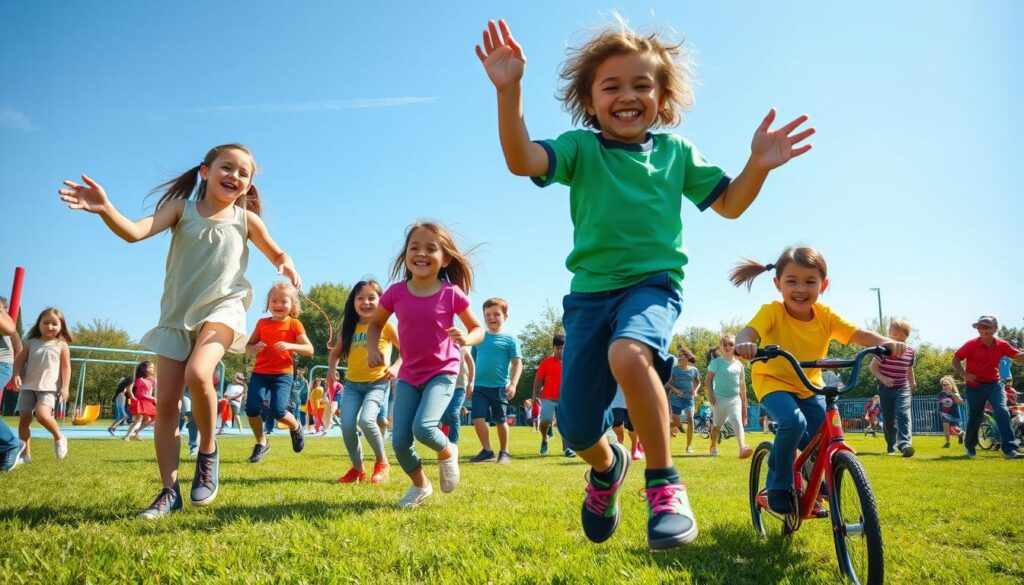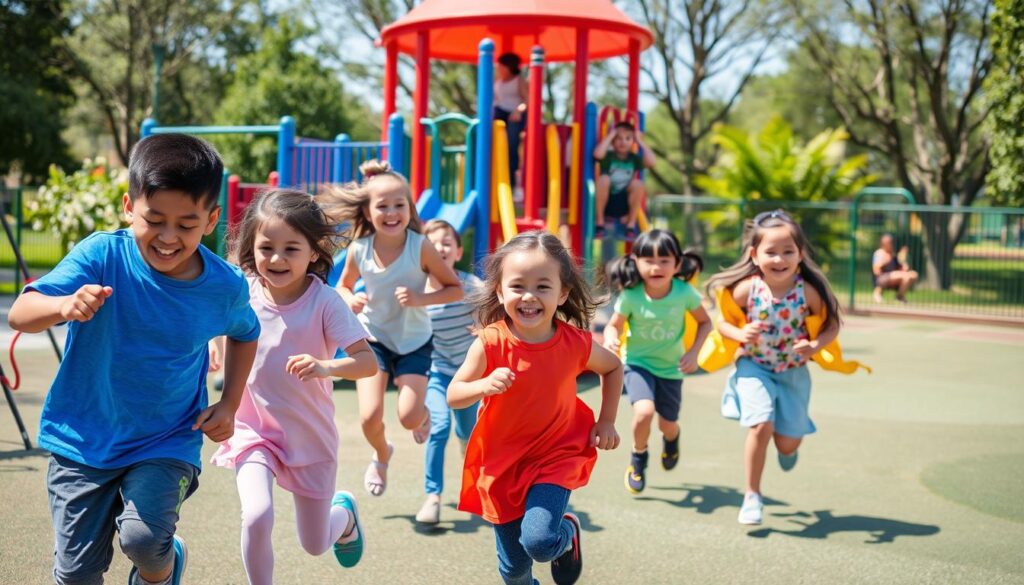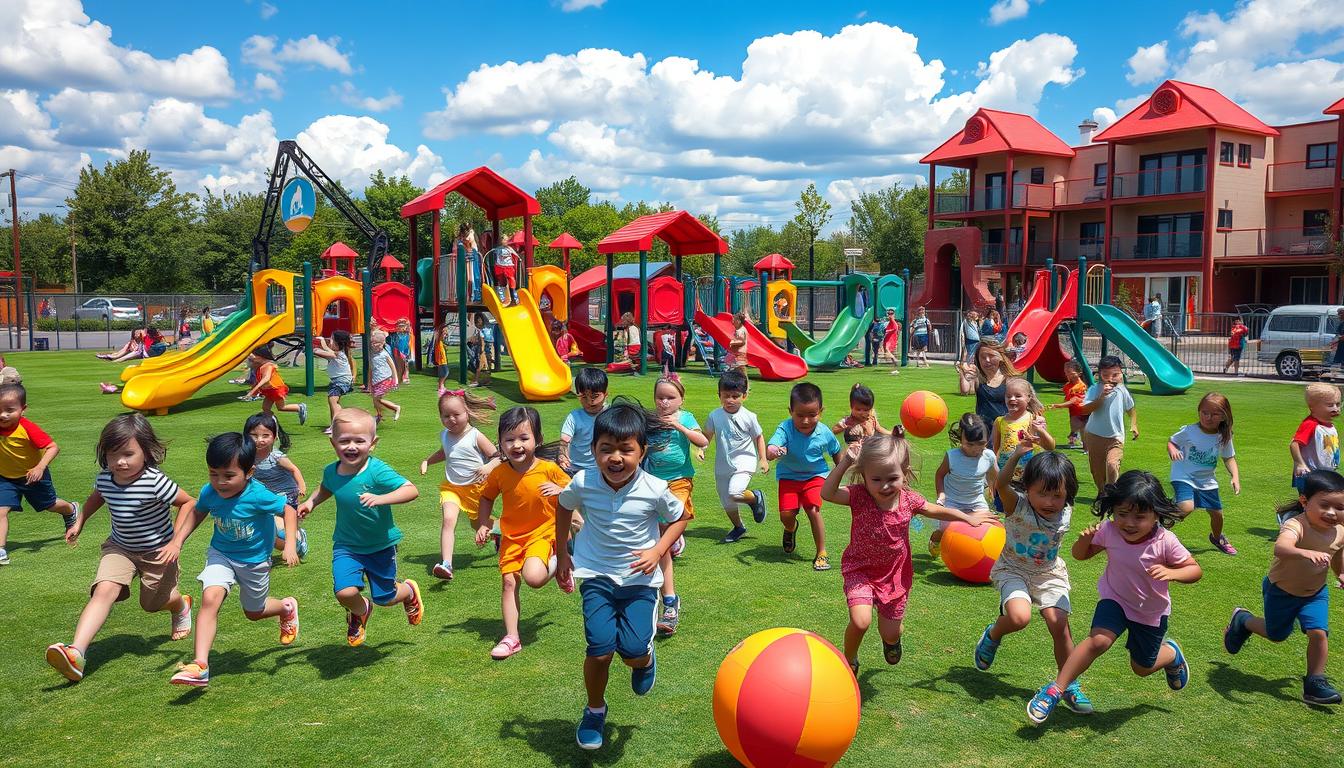As a parent, I know how vital it is to keep my kids active. Today, with so much tech and sitting around, it’s key to focus on their physical health. Exercise is essential for their growth, helping their bones and muscles get stronger, improving their thinking, and teaching them social skills.
Children’s bodies and minds are always growing and changing. Regular exercise can really help them develop healthily. By getting our kids to move and explore, we’re not just helping them now. We’re also setting them up for happy, active lives in the future.
Key Takeaways
- Physical activity is key for kids’ health and growth.
- Exercise builds strong bones and muscles, boosting their health.
- Movement boosts thinking skills and helps with learning.
- Physical activities help kids develop important social skills.
- Encouraging an active lifestyle in kids leads to healthy habits for life.
Understanding Physical Activity’s Role in Child Development
Regular physical activity is key for kids’ growth. It helps build strong bones and muscles. It also boosts brain power and social skills.
Building Strong Bones and Muscles
Activities like running and jumping are important for kids’ bones and muscles. They help make bones stronger and reduce the chance of osteoporosis later. Muscle-building exercises also help grow lean muscle, which is vital for fitness and motor skills.
Enhancing Cognitive Function and Learning
Research shows that exercise improves kids’ brains. It helps with memory, focus, and solving problems. This is important for doing well in school. School sports and physical education also help kids concentrate better and do well on tests.
Developing Social Skills Through Movement
Playing team sports or games helps kids get better at social skills. It teaches them how to communicate, work together, and solve problems. It also helps build confidence and manage emotions, making it easier to get along with others.
Knowing how important physical activity is, parents and teachers can make sure kids get to move and grow. This leads to a lifetime of health and well-rounded development.
| Benefits of Physical Activity for Child Development | Outcomes |
|---|---|
| Building Strong Bones and Muscles |
|
| Enhancing Cognitive Function and Learning |
|
| Developing Social Skills Through Movement |
|
By understanding the multifaceted benefits of physical activity, parents and educators can work together to ensure that children have ample opportunities to move, explore, and grow, ultimately leading to a lifetime of healthy habits and well-rounded development.
Move and Groove: The Importance of Physical Activity for Kids
As a parent, I know how vital it is to keep my kids active. Physical activity is more than just staying fit. It’s key for a child’s growth, helping build muscles, bones, and even their brain power. It also boosts their social skills.
Getting kids into youth sports is a great way to encourage them to move. Sports like soccer and basketball teach teamwork and perseverance. They also help kids learn to work together and develop important social skills.
But sports aren’t the only way to keep kids active. Family fitness routines are a fun way to bond and stay fit together. Activities like hiking or playing tag in the backyard are great for everyone. They make staying active a joyful part of family life.
The goal is to make physical activity fun and easy for kids. By choosing activities they enjoy, we help them develop a lifelong love for being active. This sets them up for a healthy future.
“The best way to get children to be physically active is to make it fun. When children are having a good time, they don’t even realize they’re exercising.”
| Benefits of Physical Activity for Kids | Examples of Fun Physical Activities |
|---|---|
|
|
Creating Fun and Engaging Exercise Routines for Children
Getting kids to be active and enjoy fitness is a fun challenge. As a parent or caregiver, I’ve learned that making exercise fun is key. We can do this by mixing indoor and outdoor activities and getting the whole family involved.
This way, exercise becomes a special experience that helps kids stay active. It’s all about making it fun and engaging.
Indoor Movement Activities
When it’s too rainy outside, there are many ways to keep kids moving indoors. Here are some ideas I love:
- Living room dance parties with their favorite music
- Indoor obstacle courses using household items
- Yoga or Pilates sessions tailored for children
- Living room “talent shows” that incorporate physical elements
Outdoor Adventure Games
Being outside is always exciting, and there are many ways to make it fun. Here are some outdoor activities to try:
- Scavenger hunts that get the kids exploring their surroundings
- Relay races and obstacle courses in the backyard
- Bike rides or hikes through local parks or trails
- Flashlight tag or hide-and-seek at dusk
Family Fitness Challenges
Getting the whole family involved in fitness is a great way to bond. It also promotes healthy habits for life. Here are some ideas:
- Friendly competitions like a push-up or plank challenge
- Family dance-offs to get the blood pumping
- Coordinated workout routines that everyone can participate in
- Active outdoor adventures like hiking, swimming, or rock climbing
By trying different activities indoors and outdoors, and getting everyone involved, we make exercise a fun part of our lives. With creativity and enthusiasm, we can inspire our kids to be active and healthy.

| Indoor Movement Activities | Outdoor Adventure Games | Family Fitness Challenges |
|---|---|---|
| Living room dance parties | Scavenger hunts | Push-up or plank challenge |
| Indoor obstacle courses | Relay races and obstacle courses | Family dance-offs |
| Yoga or Pilates for children | Bike rides or hikes | Coordinated workout routines |
| Living room “talent shows” | Flashlight tag or hide-and-seek | Active outdoor adventures |
Overcoming Barriers to Physical Activity in Modern Life
In today’s world, it’s hard to make sure our kids get enough physical activity. Too much screen time and not enough safe places to play are big problems. But, we can find ways to help our kids stay active and healthy.
Screen time is a big challenge. Kids love their phones and games. We need to limit their screen time and find fun, active things for them to do instead.
- Make a tech-free zone in your home, like the dining room.
- Try active video games, like Just Dance or Ring Fit Adventure.
- Go on family outings to parks or hiking trails.
Not having safe places to play is another issue. Some areas aren’t safe for kids to play outside. Look for places where kids can play safely and join in.
“The greatest wealth is health.” – Virgil
To help kids stay active, we need to make active play a priority. We should also involve our families and push for safe places for kids to play. Small changes can make a big difference in our kids’ health and happiness.

The Role of Schools in Promoting Physical Activity
“An active body leads to an active mind.” This saying is true for kids, and schools are key in promoting physical activity. They offer physical education and youth sports to help kids develop important skills.
A good physical education program keeps students active and teaches them basic movement skills. It also shows them the value of teamwork and the fun of competition. By making physical activity a part of school, kids learn to love moving and living healthily.
Schools also offer sports and clubs outside of class. These activities let kids try new things, improve their sports skills, and make friends. They help build a sense of community and teach important social skills.
Recess and free play are also vital. They give kids time to move freely and play without structure. Schools that value recess help their students stay healthy and happy.
By understanding schools’ role in promoting physical activity, we can help kids live active, healthy lives. With a mix of physical education, sports, and play, we can give them the skills and confidence to enjoy a life full of movement.
Technology and Physical Activity: Finding the Right Balance
In today’s world, technology is a big part of our lives, including our kids’. It’s great for learning and being convenient, but too much screen time can be a problem. As a parent, it’s key to balance tech use with physical activity for our family’s health.
Using tech to boost exercise is a good idea, not just to replace it. Many fitness apps and wearables make tracking and competing fun for kids. They can turn exercise into a game, making it exciting and rewarding.
But, we must limit screen time to keep active play alive. I plan “tech-free” times for my kids to play outside, move around, and do family fitness challenges. This keeps them active and engaged.
| Technology Benefits | Technology Drawbacks |
|---|---|
| Fitness tracking apps and wearables | Sedentary screen time |
| Interactive fitness games and challenges | Reduced time for active play |
| Online fitness resources and tutorials | Potential for excessive use |
By finding the right balance, I help my kids love moving and exercising. This balance is essential for their active play, fitness, and overall health.
Conclusion: Empowering Kids to Lead Active, Healthy Lives
The role of physical activity in kids’ lives is huge. It helps build strong bones and muscles. It also boosts their brain power and social skills.
By making exercise fun, we can get kids moving. Outdoor games and family fitness challenges are great ways to start. It’s up to us to make physical activity a big part of their day.
We can beat the challenges of today’s world together. We can use technology wisely and work with schools. Let’s help our kids love being active for life. This way, they’ll grow up healthy and happy.



